Today we are looking at a cooler that has been a very strong value for awhile now, the Cooler Master Hyper 212 Plus (also known as the Hyper 212+) CPU cooler. The Hyper 212 Plus is a fairly standard heatpipe tower cooler size wise and is not the best performer. What it does do well is provide fairly good performance inexpensively, often found for sub $30 and refurbished from time to time for $12. For those looking to use an older Hyper 212 Plus on a LGA 2011 Intel Core i7 or Intel Xeon E5 platform like we use on the site, the Hyper 212 Plus did not come with the stock retention bracket (it is standard on the newer models.) Cooler Master does provide a LGA 2011 bracket upgrade program for those that need it. On to the review!
Test Configuration
The test configuration for this series is going to be my single-processor LGA 2011 test bed.
- CPU(s): Intel Core i7-3930K and Intel Xeon E5-2687W at 3.1GHz
- Motherboard: ASUS P9X79 WS
- Memory: 32GB (8x 4GB) G.Skill Ripjaws X DDR3 1600
- Drives: Corsair Force3 120GB, OCZ Vertex 3 120GB 2x OCZ Agility 3 120GB
- Chassis: Corsair Carbide Series 500R
- Power Supply: Corsair AX850 850w 80 Plus Gold
This is going to be fairly typical for a LGA 2011 workstation with either and Intel Xeon or Intel Core i7 CPU.
The Cooler Master Hyper 212 Plus
Servers and workstations often come with a chassis that includes all necessary fans. Adding a cooling component to a 120mm fan mount is trivial in the context of consumer cases, while it is not a given that workstation and server chassis may not include appropriate mounting points. That is why we saw the Hydro Series coolers be so easy to mount. The Cooler Master Hyper 212 Plus is a very easy cooler to install. I use the Hyper 212 Plus and Hyper 212 EVO models quite often on personal systems and around the lab so I can do a complete installation in about three minutes at this point, including thermal paste installation. Cooler Master has a great YouTube video on installing the Hyper 212 Plus.
httpv://www.youtube.com/watch?v=hSq_xbxsm7Q&feature=plcp
The Hyper 212 Plus utilizes four heat pipes and an aluminum fin tower cooler design. One aspect that is fairly important with the Hyper 212 Plus is that the heatsink is not deep enough to interfere with installation (when fans are not installed.) Some CPU coolers have heatsinks that overhang their mounting points making installation very difficult using standard screwdrivers. The Hyper 212 Plus does not suffer from this common installation caveat.

I will note that the Hyper 212 Plus is too large, when installed, to fit in most 4 U server and workstation chassis due to its height. Although one fan is included, one can easily add a second fan for better performance. One should take care to remember that adding a second fan does negate some of the value one gets by purchasing such an expensive CPU cooler.
Performance
For Intel Xeon E3-1200 series processors, I would suggest that these CPU coolers are all overkill as 80-95w TDP is relatively low. Ivy Bridge versions are going to be 77w or less, further eliminating the need for a high-end cooler. The Intel retail CPU cooler is very sufficient in the Sandy Bridge and Ivy Bridge range. With chips such as the Intel Core i7-2600K or Core i7-2700K, i7-3770K the Corsair H80 or H100 may start to make sense because there is a lot of overclocking potential, and therefore heat available. On the lower-power platforms, the low and medium fan settings are all one needs (this one can select by simply pressing the circular fan button on the waterblock.) While that was all well and good, I decided to use some hotter processors. Namely a 150w LGA 2011 8 core/ 16 thread Intel Xeon CPU running at 3.1GHz and a Core i7-3930K running at 4.54GHz. Those two chips generate a ton of heat. To keep the CPUs loaded I am using the Folding@Home client using the -smp -bigadv flags to keep all cores and threads highly active for hours at a time. Total run time for each test was 6 hours. I probably need to find something a bit faster, but I wanted to make sure that I was getting the units good and heat soaked. My expectation is that this site has users that want continuous stability rather than a few minutes for a quick maximum benchmark run.
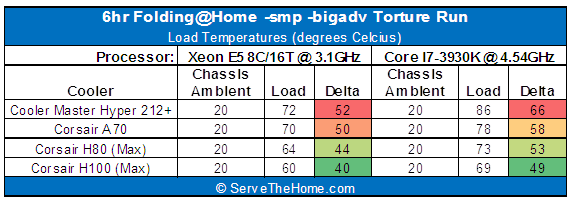
In the next few weeks I will be adding more to this little chart. The 6+ hours for each run (and I average three runs) have not given me a ton of time to test many of these at this point. A lot of other reviews I found online used overclocked 95w TDP CPUs. With the new Intel Xeon E5-2600 series 150w (at stock clocks) 8C/16T chips will be available, making it very interesting to use as a test subject at stock speeds. On the other hand, the Intel Core i7-3930K provides a very hot platform for CPU cooler testing. I prefer using these two chips as good representatives of “hot” chips.
Here is the thing, the Hyper 212 Plus does not top the charts by any means, and that was not the intent of Cooler Master. On the other hand, the Corsair A70 costs about twice as much as the Hyper 212 Plus, making the Cooler Master solution a relative value. Compared to the water coolers, the Hyper 212 Plus is about one quarter the price so Cooler Master really hit the nail on the head providing a “good enough” cooler for the market at an affordable price. Soon I will take a look at the Cooler Master Hyper 212 EVO which is slightly more expensive but does perform slightly better. For an inexpensive LGA 2011 CPU cooler for Intel Xeon or Intel Core i7 CPUs based on either Sandy Bridge (including Sandy Bridge-E and Sandy Bridge-EP) or Ivy Bridge architectures, the Hyper 212 Plus is more than adequate.
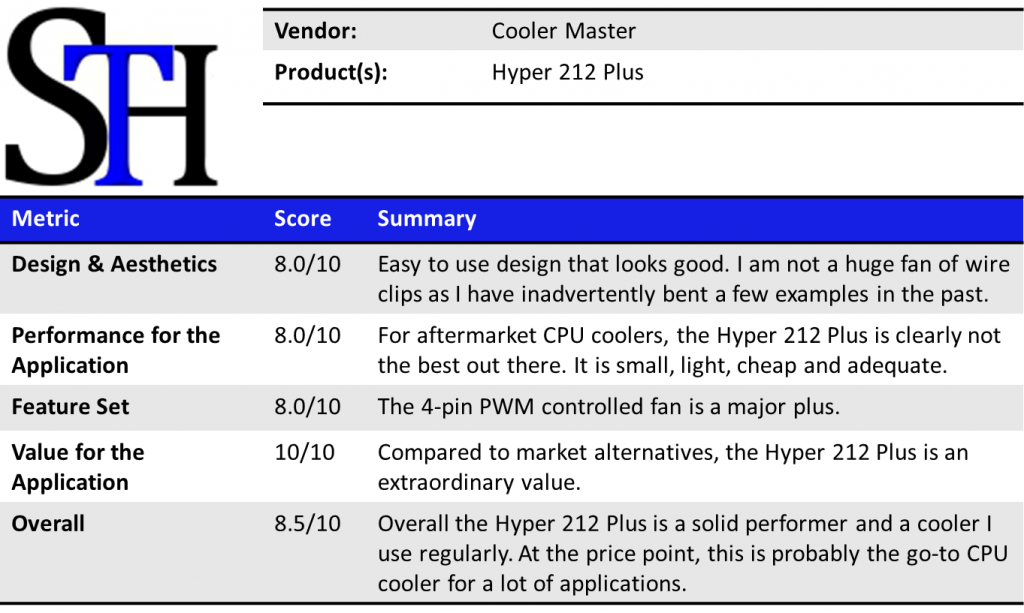

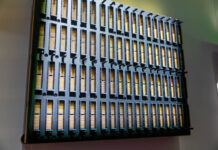
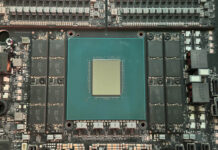
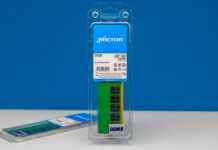
I have had six of these running for years. Refurbished ones run less than $20 shipped with tax.